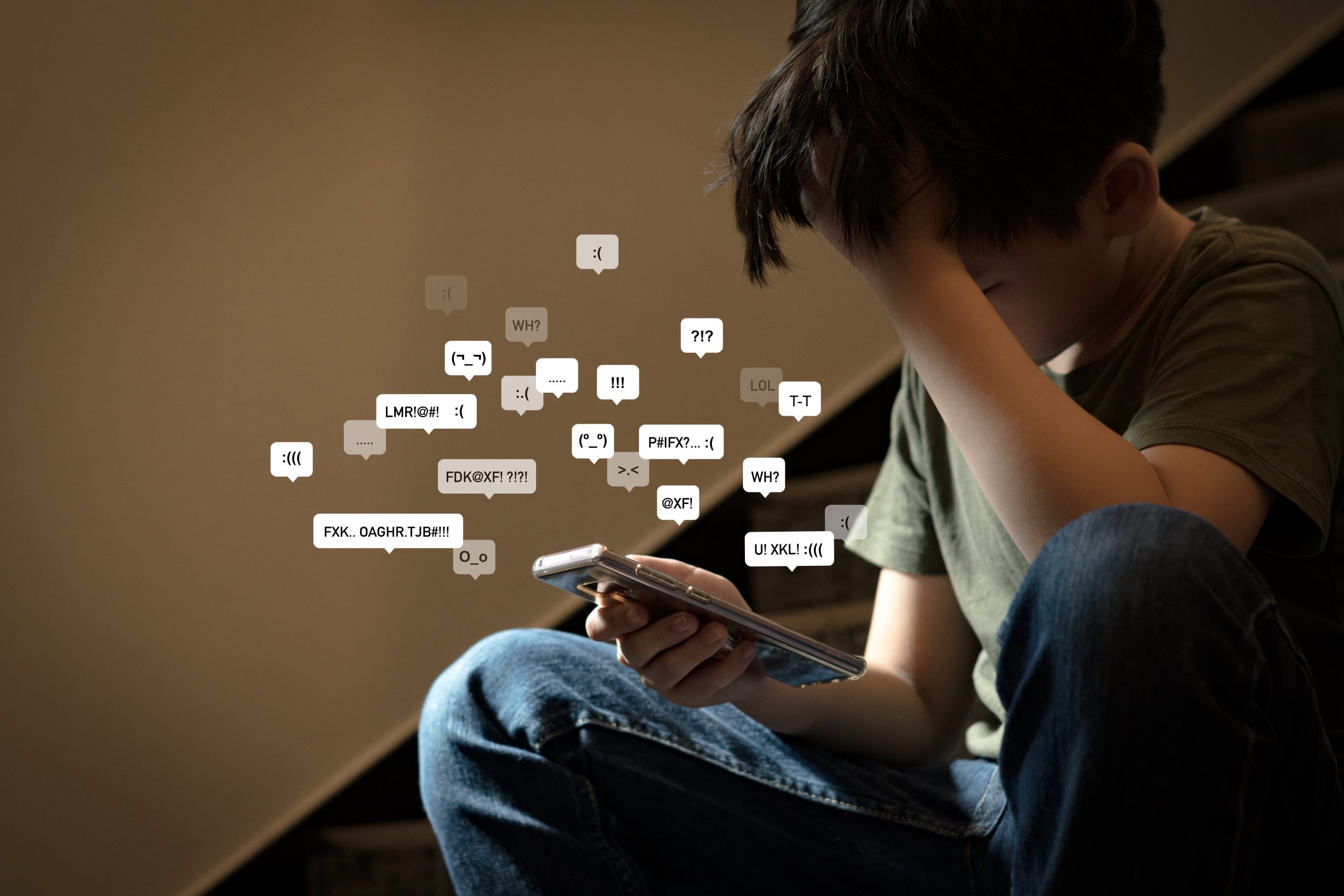1 サマリー オンラインの「見えないいじめ」をどう防ぐか
スマートフォンが生活必需品となり子ども同士のやり取りもSNS中心に移行しました。既読スルーや仲間外れのグループチャットなど画面に傷やあざは残りませんが精神的ダメージは深刻です。最近の研究ではネットいじめ経験者の四人に一人が「学校より家庭で孤立感を強く感じる」と報告しており親がデジタル空間の危険を把握する重要性が高まっています。本稿ではSNS時代のいじめ構造を分析し家庭で取るべき対策を七つの視点から解説します。柱となるのは次の三点です。
1 プライバシーと発信範囲の理解
2 オンライン行動の可視化と早期発見
3 デジタルシチズンシップ教育による予防と回復
本記事を読んだ後には子どもが安心してネットを使える環境を整え主体的にリスクを管理できるよう支援する具体策が見えてくると思います。
2 デジタルいじめの形態 既読無視から拡散炎上まで
従来のいじめは教室や校庭の物理的空間で起こるため教師や親の目に触れやすい側面がありました。一方SNSいじめは時間と場所を選ばず深夜でも続き匿名アカウントが攻撃をエスカレートさせる特徴を持ちます。主なタイプは下記の4つになります。
1 既読無視や返信差別など関係遮断型
2 誹謗中傷や脅迫メッセージを送る直接攻撃型
3 写真動画を無断で拡散し評判を傷つける公開恥辱型
4 偽アカウントを作り本人になりすますなりすまし型
特に公開恥辱型は拡散スピードが速く削除してもデータがコピーされ永続しやすい点が問題になります。子どもの心は可塑性が高い半面自己肯定感が環境に左右されやすくオンライン侮辱は人格全体を否定された感覚を招きやすいことが研究で示されています。いじめの兆候を早期に察知し介入するためには家庭で日常的にコミュニケーションアプリの利用状況を共有し「嫌なメッセージが来たらスクリーンショットを取る」など具体的行動指針を合わせておく必要があります。
3 心理的背景と発達段階 なぜSNSで攻撃が起きるのか
思春期初期は仲間からの承認欲求が高まりオンラインのいいねやフォロワー数が自己評価に直結しやすい時期です。匿名性が高いSNSでは現実よりも責任感が希薄になり共感的苦痛が感じにくくなる「オンライン脱個人化効果」が作用します。攻撃側は相手の表情や涙を見ないまま投稿できるため罪悪感を感じにくいのです。一方被害側はスクリーンを閉じてもメッセージ履歴が残り常に再生されることでストレスホルモンが長期的に分泌され睡眠障害や食欲不振を引き起こしやすくなります。発達心理学ではこの状態を「持続的刺激による情動過負荷」と呼びます。親は子どものライフステージに合わせて下記の事に留意することが重要です。
1 承認欲求を健全に満たすオフライン活動
2 スマホ使用後のクールダウン時間設定
3 感情表現の語彙を増やす対話の機会を意識的に取り入れることで心理的耐性を高める
4 家庭でできる予防策 ルール作りとオープンチャネル
ネットいじめを防ぐ第一歩はルールの共同作成です。親が一方的に決めるのではなく子ども自身に提案させることで遵守意識が高まります。具体的には下記のとおりです。
1 就寝前のスマホオフ時間帯を決める
2 アプリごとに公開範囲を家族と確認する
3 トラブル発生時の連絡先リストを冷蔵庫などに貼るなど視覚化がポイント
さらに家庭内オープンチャネルとして「今日のネットニュース共有タイム」を設け親子で問題投稿を検証しながらリテラシーを養う方法も効果的です。重要なのは批判ではなく質問で導く姿勢です。「この投稿を見て相手はどう感じるかな」と投げかけ反応を言語化させることで内省が深まります。
5 学校と地域の連携 早期発見システムの構築
学校現場ではLINE公式連携のいじめ相談窓口や匿名アンケートアプリの導入が進んでいます。家庭はこれらの仕組みを把握し利用方法を子どもと確認しておくことが必要です。地域の子ども支援センターやスクールソーシャルワーカーと連絡を取り合い早期発見率を高めていきましょう。
1 情報共有
2 カウンセリング
3 保護者勉強会を三位一体で行う
文部科学省の調査によるとSNSいじめの相談を学校外窓口に行った家庭は学校内のみより平均解決期間が三割短縮されました。親は連携会議に積極的に参加しデータと事例を持ち帰って家庭ルールをアップデートするサイクルを作りましょう。
6 デジタルシティズンシップ教育 共感と責任を育む
デジタルシティズンシップとはオンライン空間で責任を持ち他者を尊重する態度を指します。欧州の小学校ではプログラミング授業の前に下記の概念を学ぶカリキュラムが組み込まれています。
1 オンライン発言の永久性
2 著作権と引用
3 デジタルフットプリント
家庭でも自分の過去投稿を検索してみたり、画像検索で無断転載の影響を調べたり、誤情報チェックサイトを親子で体験するなど実践的学習が可能です。こうした活動を通じて子どもは画面の向こうに人間がいることを具体的に理解し共感力が高まるとともに加害リスクが低下します。
7 実践アイデア集 今日からできる五つのステップ
1 スクリーンショット日記 嫌なメッセージを保存し感情と対応策を日記にまとめる
2 バックアップ友達リスト 一緒に相談できる友人三人を事前にメモしておく
3 ポジティブ投稿チャレンジ 一週間に一度誰かを励ますメッセージを投稿する
4 ファミリーSNSチェックデー 月一回親子で設定と履歴を確認し合う
5 クールオフタイマー 感情が高ぶったら二分間投稿を保留する習慣をつける
これらは強制ではなくゲーム感覚で取り入れると継続性が高まりSNSの使い方そのものが自己調整スキルを鍛えるトレーニングになります。
8 まとめ 安心してつながるための三つの鍵
1 ルールと感情共有の継続 家庭でオープンに話せる雰囲気を維持する
2 オンライン行動の見える化 スクリーンショットや設定確認で早期兆候を捉える
3 共感と責任の教育 デジタルシティズンシップを家庭学習に組み込む
SNS時代のいじめは見えにくく迅速ですが親子で学び合う姿勢があれば被害も加害も未然に防ぎやすくなります。今日からスマホを手に取り設定と投稿を一緒に点検するところから始めてみてください。
Cyberbullying in the Era of Social Media Precautions for Digital Communication
1 Summary How Can We Prevent Invisible Online Bullying
Smartphones have become essential, and children now communicate mainly through social networking services. Read-receipt ignoring, group-chat exclusion, and unauthorized photo sharing leave no bruises yet cause severe psychological harm. Studies report that one in four cyberbullying victims feels more isolated at home than at school, underscoring the importance of parents understanding digital risks. This article analyzes the structure of social-media bullying and explains seven approaches families can apply. The three pillars are 1 understanding privacy and audience scope 2 visualizing online behavior for early detection 3 preventing and recovering through digital citizenship education. After reading, you will know concrete ways to create a safe online environment and help children manage risks proactively.
2 Forms of Digital Bullying From Read-Receipt Ignoring to Viral Shaming
Traditional bullying happens in physical spaces like classrooms, where adults can notice it more easily. Social-media bullying, however, occurs anytime and anywhere, even at night, and anonymous accounts often escalate attacks. Major types include:
1 relation-cutting such as read-receipt ignoring and selective replies
2 direct attacks with insults or threats
3 public shaming by spreading photos or videos without consent
4 impersonation via fake accounts
Public shaming spreads quickly, and copies persist even after deletion. Children’s self-esteem is highly environment dependent, and online insults often feel like rejection of their whole identity. To detect signs early, families should regularly share app usage and agree on concrete actions like taking screenshots of hurtful messages.
3 Psychological Background and Development Why Do Attacks Happen Online
Early adolescence heightens the need for peer approval, and likes or follower counts become key to self-evaluation. High anonymity online weakens responsibility and reduces empathic pain, an effect called online de-individuation. Attackers do not see the victim’s face, so guilt remains low. Victims, on the other hand, can reread harmful messages indefinitely, leading to prolonged stress hormones, sleep disorders, and appetite loss, a state called emotional overload by continuous stimuli. Parents can strengthen resilience by
1 offering offline activities that meet approval needs
2 setting a cool-down period after smartphone use
3 increasing vocabulary for emotional expression through dialogue
4 Prevention at Home Rule Making and Open Channels
The first step is co-creating rules. When children propose them, compliance rises. Practical points are:
1 deciding an off-time before bed
2 checking each app’s audience settings together
3 posting a trouble contact list on the refrigerator
Establish an “online news sharing time” to examine problematic posts with your child and build literacy. Ask questions rather than criticize: “How might the other person feel about this post?” letting the child verbalize reactions and deepen reflection.
5 School and Community Cooperation Building Early-Detection Systems
Schools are introducing counseling lines linked with LINE and anonymous survey apps. Families must know these systems and discuss how to use them. Connect with local child-support centers and school social workers to share information, arrange counseling, and hold parent workshops. Ministry surveys show that families using external hotlines resolve cyberbullying thirty percent faster than those relying only on school channels. Parents should join coordination meetings and update home rules with new data and cases.
6 Digital Citizenship Education Nurturing Empathy and Responsibility
Digital citizenship means acting responsibly and respecting others online. European elementary schools teach the followings before programming lessons:
1 permanence of online posts
2 copyright and citation
3 digital footprints
At home you can 1 search your own past posts 2 investigate the impact of unauthorized image use 3 test fact-checking sites together. Such activities concretely show that real people exist behind screens, raising empathy and lowering aggression risk.
7 Practical Ideas Five Steps You Can Start Today
1 Screenshot diary Save hurtful messages and record feelings and responses in a diary
2 Backup friend list Write down three friends to consult in advance
3 Positive post challenge Once a week post a message encouraging someone
4 Family SNS check day Review settings and histories together once a month
5 Cool-off timer Wait two minutes before posting when emotions run high
Treat these steps like a game, and using social media itself becomes training for self-regulation.
8 Conclusion Three Keys to Safe Connections
1 Ongoing rule and emotion sharing Maintain an atmosphere where talking is easy
2 Visualizing online behavior Use screenshots and setting checks to catch early signs
3 Empathy and responsibility education Integrate digital citizenship learning at home
Cyberbullying is invisible and fast, but families that learn together can prevent both victimization and aggression. Begin today by checking settings and posts with your child and keep the conversation open.




コメント